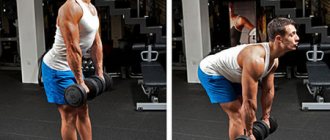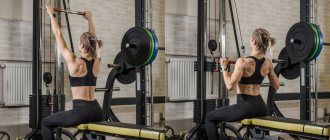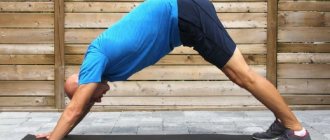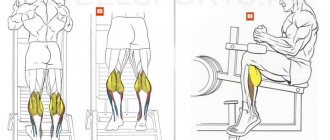Author: Timko Ilya - the ruler of the entire site and fitness trainer | more details >> Rod. 1984 Trained since 1999 Trained since 2007. Author and creator of the site tvoytrener.com. CCM in powerlifting. Champion of Russia and South Russia according to AWPC. Champion of the Krasnodar region according to IPF. 1st category in weightlifting. 2-time winner of the Krasnodar Territory championship in t/a. Author of more than 700 articles on fitness and amateur athletics. Author and co-author of 5 books.
Place in the author rating:
out of competition
(become an author)
Date:
2012-05-29
Views:
311,448
Rating:
5.0
| All articles by the author >> | Medals articles >> |
Articles are loading...
| Article medals: | more than 100 thousand views |
Why medals are given to articles:
| Bronze medal: | |
| 1. The article is in the TOP 100 2. The article has more than 3. The article has more than 100 | |
| Silver medal: | |
| 1. The article is in the TOP 50 2. The article has more than 3. The article has more than 500 | |
| Gold medal: | |
| 1. The article is in the TOP 10 2. The article has more than 1 3. The article has more than 1,000 | |
Primary muscles - extensors of the fingers and wrist Additional - pronators and suppinators of the wrist Difficulty - easy
Diamond push-ups
In regular push-ups, most of the load falls on the pectoral muscles. In diamond exercises, due to the narrow placement of the arms, the emphasis shifts to the triceps.
Place your palms on the floor so that your thumbs meet to form a “diamond.” Tighten your abs and buttocks to maintain proper body shape, lower your shoulders.
Perform full range of push-ups until your chest touches the floor.
Reverse push-ups on a bench
Another exercise without special equipment. Find a low support, turn your back to it and place your palms so that your fingers point to the sides. Thanks to this unusual positioning of the hands, the shoulder joint will protrude less forward, which means that the chances of injuring it will be reduced.
Straighten your legs, do not raise your shoulders. Lower yourself until your shoulders are parallel to the floor, and then push yourself up. Try to do the exercise smoothly, without jerking: this way you will load the triceps as much as possible and avoid injuring the joint.
Dips
This exercise can be performed with or without additional weight if your muscles are not yet ready for weighting.
Grasp the bars, do not raise your shoulders, squeeze your shoulder blades together. Lower yourself until your shoulders are parallel to the floor. Keep your body straight, do not lean forward: this will allow you to maximally load your triceps. Push yourself up and repeat the exercise.
If you still can't do dips with your body weight, try doing them with an expander. Place a resistance band over the bars, place your feet in the loop, and push up with support.
Best arm workout
A good arm workout should target both the biceps (including the biceps brachii and brachialis) and triceps (all heads), as well as indirectly the forearms . Plus, you have to lift heavy weights.
Like other muscles, your arms can benefit from high-rep exercises, but if you want to build muscle consistently, you need to focus on low-rep training.
So here's a great program to do every 5-7 days for the next 8 weeks (go to the gym!):
- Standing barbell curl. Warm up and 3 sets of 4-6 repetitions.
- Close grip bench press. Warm up and 3 sets of 4-6 repetitions.
- Hammer exercise. 3 sets of 4-6 reps.
- Push-ups on parallel bars (or from a bench). 3 sets of 4-6 reps.
- Optional: alternating dumbbell bicep curls . 2 sets of 6-8 reps.
- Optional: overhead dumbbell extensions . 2 sets of 6-8 reps.
That's all - just 16-20 heavy sets per workout.
You should not perform these exercises in superset mode. Better do it this way:
- biceps exercise;
- rest 60 seconds;
- triceps exercise;
- rest 60 seconds;
- repeat
This regime will give your muscles enough time to fully restore strength - and you will be able to put in maximum effort in each set.
Once you reach the maximum number of reps per set, increase the weight.
For example, if you do 6 reps on your first set of barbell curls, put 5 pounds on each side of the barbell and work with that weight until you can do 6 reps, and so on.
French bench press with barbell
For this exercise, you can use different bars: straight, EZ or W. A curved bar allows you to grab the barbell at a slightly angle - it’s more comfortable.
Lie down on a bench with your feet flat on the floor. Raise the barbell in front of you and place your arms straight behind your head. If they are perpendicular to the body, the triceps will rest at the extreme point.
Now bend your elbows and lower the barbell behind your head. The shoulders do not change their position, only the forearms work. Bring the barbell back and repeat.
Execution technique
French press with dumbbells standing
Original
- The projectile is taken from the racks with both hands or from the floor by the discs with a locking grip;
- By bending the knee and hip joints, the dumbbell is removed from the floor or racks and thrown back to its original position in one movement;
- The elbows are “in” at the top, the arms are fully straightened;
- The shoulder blades are brought together, the back is slightly arched and tense;
- The abdomen is retracted, the spine is in the anatomically correct position for it, there is no need to bend in the thoracic or lumbar region
Movement:
- Bend your knees slightly to soften your stance;
- Bend your arms at the elbow joints and smoothly lower the dumbbell behind your back;
- Exhale and straighten your arms at the elbow joints, smoothly squeezing the dumbbells upward;
- Do not change the position of your hands on the bar during the exercise.
It's the FRENCH DUMBBELL PRESS, baby.
Seated French press with dumbbells
This exercise can be performed sitting on a dumbbell bench with a backrest, or on a Scott bench, with your back to the biceps racks:
- Take the starting position, dumbbell bar between your thumbs, hands intertwined on the discs;
- Bend your elbows and lower the dumbbell behind your back;
- Extend your arms smoothly, squeezing the dumbbell to the starting position;
- Perform the required number of repetitions as planned
Attention
- The bench press is performed without bending the lower back. It can only be small, determined anatomically; the “bridge” movement should not be performed;
- Elbows should not be spread, forearms should be parallel to each other;
- Shoulders should not rise up or move forward and sideways when performing presses;
- Triceps work better if the position is vertical
Recommendations
- There is no need to “stuff” your neck with a dumbbell. If the discs touch the vertebrae, you should choose a narrower apparatus, or refuse to perform this movement variation and do the exercise in the “one-armed” version;
- The dumbbell cannot be “dropped” down or pushed below the amplitude that is permissible with the natural movement of the arms. Athletes with large biceps should not “clamp” their arms so much that it becomes uncomfortable;
- It is not recommended to work in the upper third of the amplitude, in order to avoid overstretching the elbow ligaments; it is better to perform the movement completely, but use less weight on the projectile than partially, but constantly;
- The bar should fit between your index fingers and thumbs. The grip, when each hand takes the disc separately, is not entirely comfortable and is not anatomically the most advantageous;
- A belayer is necessary not only for heavy lifters, but also for beginners who may not feel very confident.
French press with dumbbells standing and sitting: execution technique
Dumbbell overhead press
In this exercise, the triceps are first stretched under load and then contracted to return the arms to the starting position.
Grasp the dumbbell plate with both hands, lift it and move it behind your head. Now bend your elbows, lower the dumbbell and raise it again. Make sure that your shoulders do not move: only your forearms work.
Technique for performing barbell curls while standing
Now that we know what grips exist and what muscles they are aimed at developing. We can safely begin the technique of performing the exercise.
- Take the barbell in your hands with your chosen grip. Stand straight with your feet shoulder-width apart and your knees slightly bent. The shoulders are lowered down so that the shoulders do not participate in lifting the barbell. Tilt your body slightly forward.
- We begin to bend our arms at the elbow joints, thereby lifting the barbell up. And we breathe out. In this case, the elbows are pressed to the body and directed towards the floor. No need to lift them up!
- We extend our arms and return the bar to its original position, inhale.
- Repeat as many times as necessary.
Since the biceps is a small muscle, it is better to work with a high number of repetitions in each approach. At least 12 times. Maximum 21. Why 21? Everything is simple here. It’s like you’re setting an extra task for yourself. You need to do 20 repetitions, but if you aim for this number of times you will do it. And when you set a goal of 21 times, then when you reach 20 you will tell yourself: - Stop, I still need to do it 1 time. And you are more likely to do it, thereby loading your biceps even more. Everything seems simple, but the result is colossal!
Bent-over arm extension with dumbbells
This exercise works not only the triceps, but also the posterior deltoids. These are small and weak muscles, so don't use too much weight.
Bend forward with a straight back, bend your arms with dumbbells at the elbows at right angles and keep them close to your body.
Extend your arms and then return to the starting position. Do not change the angle of your back, do not move your shoulders - only your forearms work.
Extension of the arms at the wrists with an overhand grip of the bar[edit | edit code]
Extension of the arms at the wrists with an overhand grip of the barbell
- Isolated/single-joint
- Traction
- Open circuit
- With a barbell
- Beginner and advanced levels of fitness
This exercise is ideally combined with the exercise “bending the arms at the wrists with an underhand grip of the barbell.”
Brief description of the exercise
Extend your wrists with the backs of your hands facing you as you lift the barbell. Return to the starting position and repeat the exercise.
Stabilizing muscles
- General stabilization of the torso.
INITIAL POSITION
- Sitting forward. Take the barbell with a narrow overhand grip or a medium grip, shoulder-width apart.
- Rest the outer surface of your forearms on your thighs so that your hands hang from your knees.
Tips on proper exercise technique
:
- Maintain a balanced posture; the spine is in a neutral position.
- Perform a slow, controlled movement, do not use inertial force.
| Motion Analysis | Joint |
| Joints | Radiocarpal |
| Directions of joint movements | Up - extension Down - flexion |
| Mobilizing muscles | Extensor carpi radialis longus Extensor carpi radialis brevis Extensor carpi ulnaris |
Extension of one arm with support on the bench
Unlike the previous exercise, here you lean on a bench and work with one hand. Therefore, you can take more weight and pump up your triceps better.
Place your left hand and knee on the bench, keep your back straight and shoulders down. Take a dumbbell in your right hand, bend your elbow at a right angle. Straighten it, keeping it close to your body, and then return it back.
Extension of arms on a block with a rope handle
Turning your arms outward allows you to place more load on the lateral head of the triceps, that is, its outer side.
Hang a rope handle on a block and grasp both ends. Take a stable position, straighten your back, lower your shoulders, keep your elbows close to your body.
Pull the handle down until your arms are straight. At the same time, spread the ends of the handle, turning your elbows to the sides.
Extension on the block from behind the head
In the starting position, the triceps are stretched. This increases the load on the muscles and allows you to work them out better.
Stand with your back to the block, grab the rope handle and lift it above your head. Bend your elbows at right angles and place your bent leg forward to take a stable position.
Now straighten and bend your arms.
Correct technique
The barbell wrist curl is an easy exercise, but that doesn't mean beginners don't need to learn the technique. The fact is that incorrect bending can lead to injury, so in order to protect yourself from injury and at the same time strengthen your grip, you must:
- Take the starting position. To do this, the athlete sits on a comfortable horizontal bench and takes the barbell in his hands with a reverse grip (palms facing the ceiling). The forearms should be positioned so that they are parallel to each other. The hands are well strained under the weight.
- The fingers hold the bar tightly, preventing it from swinging throughout the exercise. It is important to keep the forearms and elbows stationary, as any unnecessary movement can tire the athlete in advance.
- The wrists slowly bend, keeping the bar horizontal. At the top point of the amplitude, a short pause is waited, after which the wrists return to their original position.
- The barbell is twisted upward without unnecessary delay due to the strength of the forearm muscles, and then the arms are bent at the wrists.
- The required number of repetitions is performed.
This exercise can be done with a straight or curved bar. It is important to choose the most convenient option for yourself so that you do not feel discomfort in the wrist area. Some people find it convenient to do it with a straight bar, while others prefer a curved bar. It all depends on personal preference. Beginners can replace the barbell with dumbbells.
Beginner men are recommended to work with a barbell weighing 15 kg, and girls - no more than 12. It is enough to do 10-15 repetitions in one approach so that the muscles of the forearm and hand receive a good load. It is advisable to perform 2 or 3 such sets depending on the athlete’s level of fitness.











